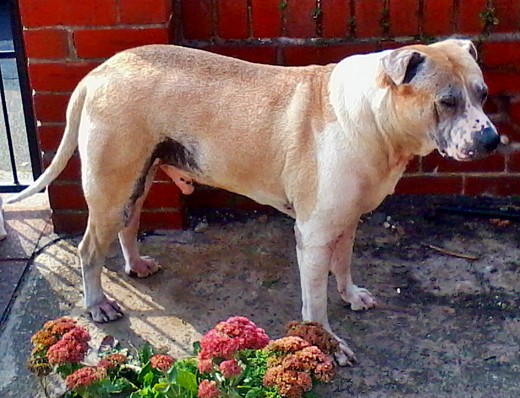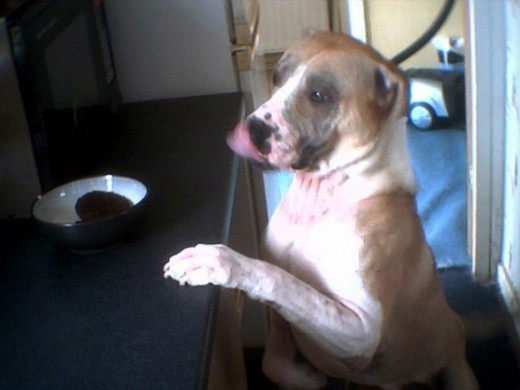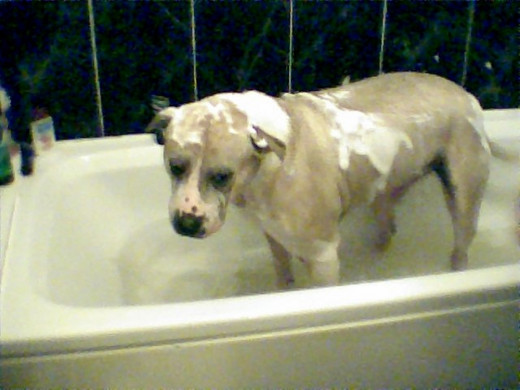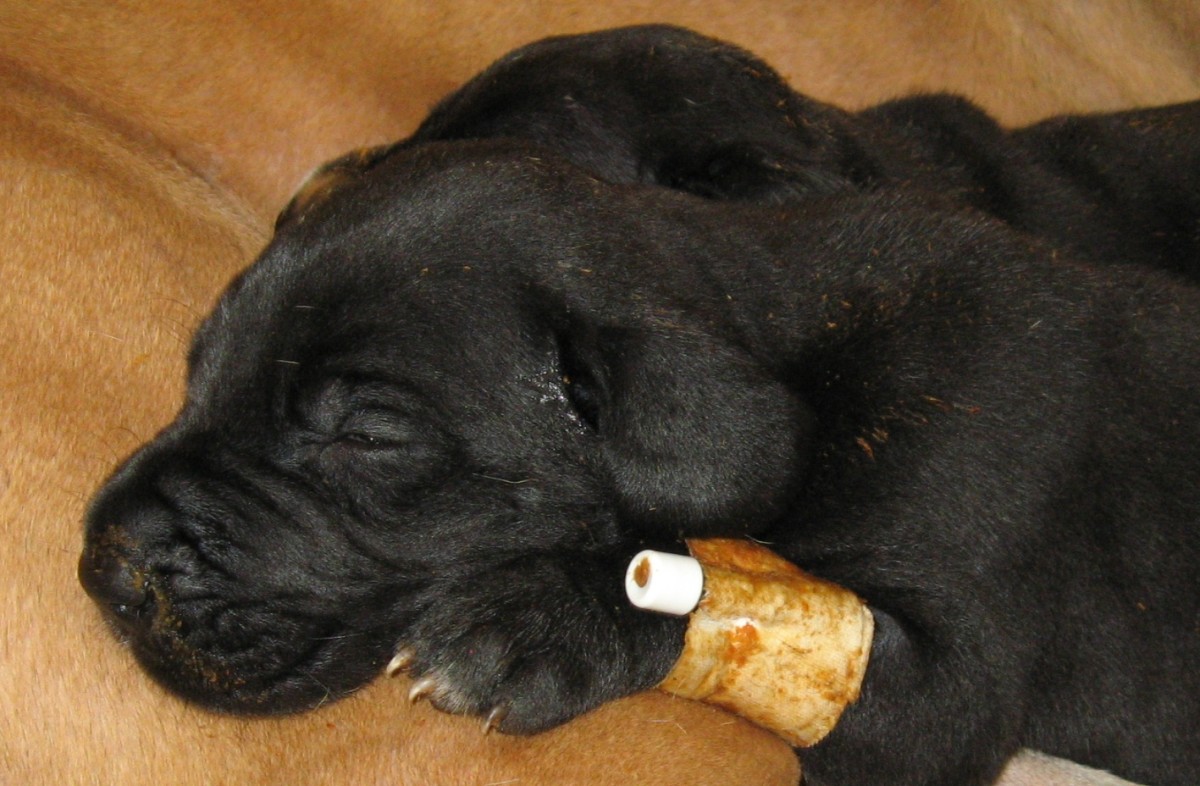- HubPages»
- Pets and Animals»
- Dogs & Dog Breeds»
- Dog Health
Caring for a Dog with a Dry Skin Condition

Roy was such a perfect puppy!
Roy was one of an accidental litter of puppies and I fell in love with him from the start.
He was the tiniest puppy and spent much of his young life sleeping on a cushion, seemingly oblivious to the fact there was a big, wide world out there.
He was so cute it was unbelievable and I just wanted to hug and kiss him all the time.
He became very good friends with Pepper, an abandoned kitten I had taken in, who was just a little older than Roy.
So whereas he used to nap on his own, he soon had Pepper snuggled up next to him. They have remained good buddies ever since.
Roy started growing up into a little dog with lots of character and was soon running round the house wreaking havoc, including helping my other dogs eat the settee on one of the first occasions I left them alone in the house while I went shopping.
But when he was about six months old, I noticed dry, flaky patches starting to appear on his skin.


An itchy dryness spread over his body
At first, they were not too bad, just afflicting a small area on his stomach. I took him to the vet's, where he was prescribed a course of antibiotics.
But these didn't really make much difference and the dry skin began to worsen.
The vet seemed baffled as to the cause and prescribed a longer course of antibiotics (six months) plus medicated baths.
However, the dryness spread all over his stomach and on to his back legs, feet and chest. It was obviously causing itchiness as well and he was forever scratching himself.
A skin biopsy failed to find the cause
I went to a different vet, who said mites in the hair follicles could be causing the skin problem and suggested a biopsy to test for this.
However, the test came back negative and mites were not the problem.
By this time, the soreness had spread to his ears, which ended up bald, as did his feet and chest.
The antibiotics seemed to temporarily slow down the spread of the dry patches, but perhaps he became immune to the medication after prolonged use, as his skin was getting worse and was red much of the time.


Dog warden called to check on his welfare
Despite his itchy skin, he was still a happy little soul and he didn't let it interfere with his life. He was the bounciest little dog I had ever known and loved his food so much, he would literally jump about four feet in the air if I was holding up a treat and just kept on bouncing till I dropped it in his ever-open mouth!
I continued taking him to the vet's for regular check-ups, but none of the medication seemed to work long-term and I was at my wit's end wondering what we could do for him.
Most days, Roy, oblivious to all the fuss, would be lying on the back of the settee in the lounge window, watching the world do by.
This led to a rather unfortunate visit from the dog warden. Apparently, a passer-by had seen Roy through the window and thought he was a victim of neglect. This well-meaning stranger reported me to the authorities, claiming I had an abused dog, which led to the dog warden's visit.

I consulted a third vet to try to find a cure
When the dog warden arrived, although I knew the person who reported me had Roy's best interests at heart, I felt furious and found the visit very intrusive.
She asked to look at Roy and asked if I had taken him to the vet's to have his skin examined! Obviously, I had, but I was told I must show her all my receipts proving he had received veterinary care. Only after I showed her his medication and the receipts showing I had spent several hundred pounds (in particular on the biopsy) was she satisfied he was not being neglected.
However, her next comment left me dumbfounded - she suggested Roy "couldn't have much quality of life" and asked if I had considered having him euthanised!
I'm afraid my polite demeanour vanished in an instant and I told her to leave! Roy was - and remains - the most joyful character you could ever meet and the thought of deliberately having him killed because he had dry skin made me see red.
After all, nobody would consider euthanising a human who had eczema, for example, so why should we end a dog's life for that reason?
I did decide, however, to try a different vet, as I thought the current treatment obviously wasn't working if Roy was suspected of being a neglected dog.


At last a treatment began to work
My new vet was a little scathing, I have to say, telling me Roy's skin looked awful and (a little like the dog warden) seemingly found it hard to believe he had received so much treatment. However, I had his records transferred to the new surgery so she could see exactly how many visits to the vet's he had endured over the years.
She arranged for another biopsy to try and find out the cause. I felt sorry for him having to undergo another general anaesthetic in order to have the procedure, but thought if it helped him, it was a necessity. By this time, he even had patches of dry skin on his face and I just wanted to sort it out and find a cure.
When I returned to the surgery for the results, I was happy to discover the female vet was off that day and instead I saw a new, young, male vet. This was five years ago, when Roy was three years old. We have been with this particular vet ever since, as he was a miracle worker.
He was the first vet who gave Roy a combination of antibiotics, steroids and medicated baths. After a few weeks, there was a marked improvement in his skin and the patches on his face had cleared up, while hair was growing back on his ears for the first time in two years.
Roy barks for his supper - with Squeaker who is much quieter!
Finding the right balance of medication is important
Sadly, the second biopsy proved as inconclusive as the first, as did blood tests. The cause of his dry skin still remains a mystery.
The vet suggested we would have to proceed with a system of "trial and error" until we got the correct balance of medication.
I was also told not to use any cleaning products in my home which might adversely affect him in case it was an allergy. This meant no bleach and no "shake and vacuum" scented cleaning products on the carpets.
After a prolonged course of antibiotics coupled with a fairly strong dose of steroids, his skin started looking much better. The redness was replaced by a normal skin colour and the angry patches that had flared up on his chest, hind legs and feet calmed down too.


Electric fire worsened his skin condition
One thing I hadn't bargained on was Roy's love of my electric halogen heater, however. I bought one for the upstairs landing one particularly cold winter, as the dogs often lounged around up there and I felt it was too chilly.
But Roy became addicted to absolutely toasting himself as close to the fire as he could manage. Unfortunately, the heat started making his skin dry again, so I had to moderate use of the fire and make sure he never sat too close.
Luckily, the setback was only temporary.
Eventually, the vet was able to take him off the antibiotics altogether and reduce the strength of the steroids, although Roy will have to remain on medication and keep having the medicated baths probably for the rest of his life.

Vital to keep a close check on his weight
One of the side effects of steroids is that they can make a dog continually hungry and gain weight.
Roy has always loved his food. However, I now have to be very careful not to overfeed him and also I never leave any half-eaten cat food lying about, or he will raid the bowls.
I hadn't realised at first that this was a side-effect of steroids and I was horrified, when Roy went for his three-monthly weigh-in and check-up, to find out he had gained two kilos.
However, after the vet explained this to me, I made sure Roy had a healthy diet and cut down on the treats and snacks.
The right medication made him look like a different dog
I am so happy I found my current vet, as he persevered with Roy's treatment until we found the right balance. Now, his skin is almost back to normal.
The vet says it will probably never be perfect, but fur has now started to grow back even on the most stubborn spots and he looks like a different dog.
He is so full of the joys of life that it is a pleasure to spend my time with him and he NEVER scratches now, so all the skin irritation has gone completely.
To anyone who has a dog with a skin condition, I would say persevere, no matter how long it takes, as finding the right mix of medication can work wonders for your dog. Never let anyone tell you he "can't have a good quality of life" as this is totally wrong, as Roy has proved.

Footnote
Roy is now 12 years old, as of March 2018, and is still enjoying life. He has slowed down somewhat and is on rheumatism medication for his hind legs, as well as his dry skin treatments.
But he is still a happy boy and loves his food, short walks and riding in the car.
Although my regular vet retired - much to Roy's dismay - his replacement has kept Roy on the same tablets (piriton, prednisolone and medicated baths) and we have kept his dry skin under control.
I keep thinking back to the dog warden, all those years ago, who thought his dry skin condition was a cause for euthanising him because he "wouldn't have much quality of life"! I'm still astounded by this view!
I can vouch for the fact that many years down the line, on the contrary, Roy has enjoyed a wonderful life and I hope he will continue to do so for a long time.









